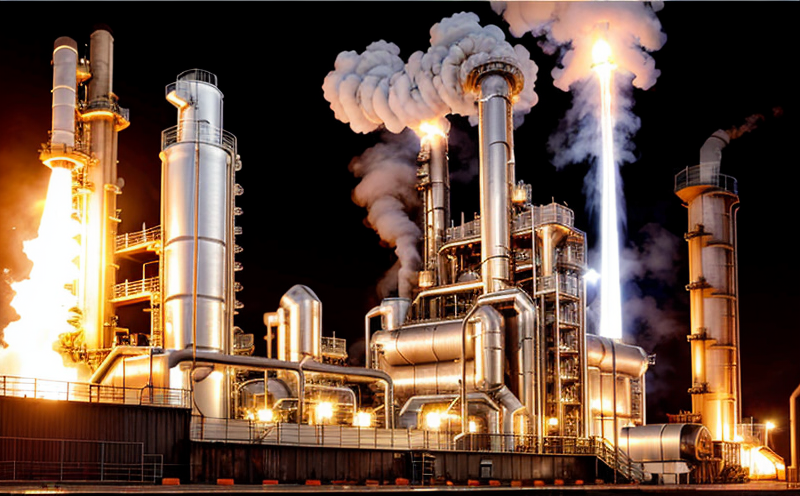ISO 15356 Determination of Oxygen in Stainless Steels
The determination of oxygen content in stainless steels is a critical parameter in the quality control and process optimization of metal production. This test method, as defined by ISO 15356-1:2018, is widely used to ensure that stainless steels meet the specified oxygen content limits set forth in relevant standards such as ASTM A240 and SAE J461. Oxygen content is a key indicator of the purity of stainless steel, which directly impacts its mechanical properties, corrosion resistance, and overall performance.
The ISO 15356 method utilizes gas analysis techniques to measure the oxygen content in solid samples. The process involves several steps: sample preparation, homogenization, and then precise measurement using a high-precision gas analyzer. This ensures that the oxygen content is accurately determined without affecting the mechanical properties of the material.
The test procedure starts with carefully selecting representative samples from the batch or production run. These samples are then prepared by grinding into a fine powder to ensure uniformity. The powdered sample is placed in a sealed crucible, which is heated under controlled conditions to drive off any volatile components such as water and carbon dioxide. This step ensures that only oxygen remains for accurate measurement.
The crucible containing the sample is then introduced into the gas analysis system where it undergoes further heating to release the oxygen. The released oxygen is captured in a carrier gas stream, which is then analyzed using a thermal conductivity or infrared detector. This method provides highly precise and repeatable results.
Understanding the significance of this test for stainless steel production is crucial. Oxygen content can vary based on the refining process used, the raw materials employed, and environmental factors during processing. By ensuring that the oxygen content meets specified limits, manufacturers can enhance the performance of their products, reduce the risk of corrosion, and extend service life.
The ISO 15356 method is particularly useful in industries where stainless steel is a critical component, such as aerospace, automotive, and medical device manufacturing. In these sectors, the integrity and durability of materials are paramount. Accurate oxygen content measurement ensures that products meet stringent quality standards, thereby enhancing customer satisfaction and reliability.
For research and development teams, this test method provides valuable insights into the refining process and its impact on material properties. By monitoring oxygen content during various stages of production, R&D engineers can identify optimal conditions for minimizing oxygen contamination while maintaining desired mechanical characteristics.
In summary, ISO 15356 is a vital tool in the metallurgical industry, providing precise measurement of oxygen content in stainless steels. It supports quality assurance and process optimization, ensuring that products meet critical performance requirements and regulatory standards.
Applied Standards
The ISO 15356 method is primarily applied to comply with the following international standards:
- ISO 15356-1:2018: Determination of oxygen in stainless steels – Part 1: Gas analysis method
- ASTM A240: Specification for Stainless Steel Seamless Tubing
- SAE J461: Specifications for Stainless Steel in Automotive Applications
These standards mandate the use of precise oxygen content measurement to ensure that stainless steel products meet specific quality and performance criteria. Compliance with these standards enhances product reliability, safety, and longevity.
The method is also referenced by other industry-specific documents such as those from the American Society for Testing and Materials (ASTM) and the Society of Automotive Engineers (SAE), further emphasizing its importance in various sectors.
Benefits
- Enhanced Material Quality: Accurate oxygen content measurement ensures that stainless steel meets specified quality standards, leading to improved mechanical properties and enhanced performance.
- Precise Process Control: By monitoring oxygen levels during production, manufacturers can optimize their refining processes for better efficiency and consistency.
- Increased Product Reliability: Reduced oxygen content in stainless steel enhances its corrosion resistance, ensuring longer service life and reliability.
- Regulatory Compliance: Adherence to international standards ensures that products meet regulatory requirements, avoiding potential legal issues and penalties.
- Cost Efficiency: By minimizing oxygen contamination during production, manufacturers can reduce waste and improve resource utilization, leading to cost savings.
- Better Customer Satisfaction: Products that consistently meet quality specifications are more likely to satisfy customer expectations and build trust in the brand.
The ISO 15356 method provides a robust framework for achieving these benefits, ensuring that stainless steel products are reliable, safe, and of high quality.
Why Choose This Test
- Precision: The gas analysis method used in ISO 15356 provides highly precise and repeatable results, ensuring accurate oxygen content measurement.
- Compliance: Compliance with international standards is crucial for meeting regulatory requirements and maintaining product quality.
- Consistency: By monitoring oxygen levels during production, the test ensures consistent material properties across batches and runs.
- Optimization: This method allows manufacturers to optimize their refining processes for better efficiency and consistency.
- Reliability: Reduced oxygen content in stainless steel enhances its corrosion resistance, ensuring longer service life and reliability.
- Expertise: Our laboratory is staffed with experts who have extensive experience in performing this test accurately and efficiently.
The ISO 15356 method offers a comprehensive approach to oxygen content measurement, providing reliable data that supports quality assurance and process optimization. Choosing this test ensures that your stainless steel products meet the highest standards of quality and performance.





